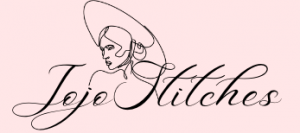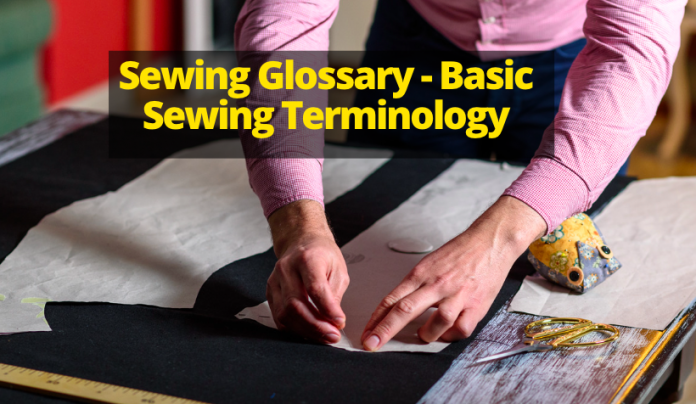Sewing Glossary – Basic Sewing Terminology
With this beginner’s sewing glossary, you’ll learn the basics of sewing and some helpful hints and tips. Currently, the list is a work in progress, and I’ll be adding links to tutorials, images, and videos as they become available.
A
Allowance for seams
The fabric located between the edge of the fabric and the stitch line is known as the stitch line. The width of a pattern can differ between companies and within a garment. Always double-check the pattern descriptions and pattern pieces before cutting out the pattern. Finishing the seams.
A rough edge
The fabric’s cut edge is raw, raveling, and unfinished, and it shows this.
Armscye
It is where you attach the sleeve to the bodice, referred to as the armscye or armhole.
B
Backstitch
This secure the stitches at the beginning and end of a seam with 2 or 3 reverse stitches backstitching them together. A backstitch or a back tack will help to keep the stitches in place and prevent the seam from coming undone later on.
Bar tack
To reinforce or hold a facing in place, bar tack a small row of narrow zig-zag stitches across the surface. You can use them on the fly of jeans, the belt loops of a pair of jeans, and buttonholes.
Bias
Bias is the diagonal direction of a piece of fabric that is drawn at a precise 45-degree angle to the selvage or grainline of the fabric in question. Even when it is a non-stretch fabric, woven fabric has the greatest stretch when stretched in this direction.
Bobbin
A small spool of thread is inserted into your sewing machine and is used to supply the bottom thread in your stitches. It is loaded into the bobbin case and placed into the sewing machine’s needle position.
Buttonhole
It is necessary to create a reinforced hole in the fabric that is slightly larger than the button passing through it.
C
calico
calico The fabric frequently has small brown specks in it caused by the husk of the cotton plant. Because it is a relatively inexpensive fabric, it is ideal for determining the fit of a garment.
Clipping
Clipping will give you better results in convex (scalloped hem) curves than drawing them freehand. A clip is a snip made in the direction of the stitching cut close to the stitch line but not through it completely to achieve the best results.
D
Darts
Dart is important to shape the garment around the waist, bust, shoulders, and, occasionally, the sleeves to shape the garment. They are mostly shaped in the manner of triangles or diamonds.
E
Easing into
When one of two pattern pieces, which must fit together, has excess fabric, you must ease it in gradually. For example, sleeve caps frequently have an excess of fabric that needs to be pushed in. Before you set in the sleeve, you can slightly gather the excess fabric without creating wrinkles to distribute the excess fabric evenly.
Edgestitch
The stitching that runs close to the edge of a seam, hem, or pocket opening is called a bound edge. Frequently, the edge is only a needle width away (0.15 cm / 1/16″) from the center.
F
Facing
Generally speaking, they are a partial lining often made from the main fabric used on the neckline and armholes of garments.
G
Gathers
Gathered fabric is used to add fullness and ruffles to garments. Depending on how much room you have, you will sew one or two lines of gathering stitches just inside or outside the stitch line. To make gathering easier, use a long stitch length (5mm or longer) and loosen the top tension on your sewing machine.
H
Hem
It is done by folding the bottom edge of your garment inwards and towards the inside of the garment.
I
Interfacing
It is necessary to add a layer of fabric to stabilize the garment, give it structure, give it “crispness,” and provide strength. It is a layer of fabric placed between the lining/facing and the outer fabric of a garment.
Interlining
A layer of fabric used to increase the warmth of a garment. It is best positioned between the outer fabric and the garment’s lining.
Invisible zipper
The zipper is virtually indistinguishable. This zipper is sewn with a unique presser foot that seems unique to this project. Once done correctly, it’s difficult to tell that there’s a zipper in the seam, hence the name.
L
Lining
A layer of fabric placed inside a garment to conceal construction seams and details, provide warmth, make it more comfortable to wear, and make it easier to put on is a lining or gusset.
M
Machine basting
Loose stitches that gather fabric or hold something in place for a short period. Alternatively, you can use the longest stitch length on your sewing machine to complete the task by hand.
Mark
Making the transfer of pattern symbols and markings from paper to fabric. We use fabric markers, thread, chalk, and pins to create tailor’s tacks, then adhere them to the garment with pins.
N
Notch
Notching will give you better results in concave (neckline) curves than cutting straight across. A notch can also refer to a marking on a pattern used to help two pieces align with one another. You can frequently find them on a long seam or curved pattern piece.
P
Pins
They are made in various lengths and thicknesses, with or without colorful ball-shaped glass heads.
Placket
Partially buttoned closure. Sleeve cuffs, polo shirts, pop-over shirts, and anoraks all have these plackets.
Pressing
Seams can be pressed open or to one side with an iron. To achieve the best results, do this while working on your garment.
S
Stitching in the round
Simply hand-sewn stitch that weaves up and down the fabric, creating a dashed line of stitches. It is used for basting, and gathering fabric, also referred to as running stitches.
Seam
It is the line where you will sew two pieces of fabric together. There are a variety of seams.
Seam ripper
A seam ripper is a small simple tool used to remove a row of stitches from a garment. When the knife becomes dull, it is necessary to replace these.
A seam ripper is a small simple tool used to unpick stitches in clothing.
T
Tacks
To transfer pattern markings onto the fabric, use loose hand sewed stitches to transfer the markings.
Topstitch
Topstitch is a line of stitches on the outside of a garment used to finish it. You can use topstitching for a variety of purposes, including:
Back pockets on jeans, for example, can be used as a decorative element.
The right-hand side
It is also known as the face of the fabric. It is the side of the fabric that is visible from the outside of the garment.
Trim
Reducing the width of the seam allowance to a more manageable size. Trimming will reduce bulk fabric and make curved seams easier to handle.
U
Underlining
Underlining is an extra layer of fabric cut to look like a duplicate of a section of the garment. When working with sheer fabrics, underlining provides an opaque backing. It is used as a backing for a fabric prone to shifting.
W
Wrong Side
The reverse of the fabric and the inside of the garment are both examples of this. If it’s difficult to tell which side of your fabric is the right side or the wrong side, mark the fabric with pins or chalk to make it easier to see.
Z
Zig-Zag Stitches
It is a Z-shaped stitch used on knits and stretch fabrics to sew buttonholes and as a finishing stitch for unfinished edged garments. Zig-zag stitches on a knit fabric are an example of this.
Zipper Foot
Depending on the situation, a zipper foot can be attached to the sewing foot ankle on either the left or right side.
We appreciate you taking the time to read!
Finally, we hope you found this article interesting? And what do you think about ”Sewing Glossary – Basic Sewing Terminology”
Please feel free to share your thoughts with us in the box below.
Check the facts
Please contact us if you would like to contribute to this article or advertise with us.
And let us know if you notice something that isn’t quite right













